Project Evaluation: NPV, Payback Period & Investment Decisions
VerifiedAdded on 2023/06/08
|7
|1378
|344
Report
AI Summary
This report provides a detailed analysis of two potential projects for S&P plc, a bag manufacturing company, using Net Present Value (NPV) and Payback Period (PBP) methods. It compares these two techniques, highlighting the advantages and disadvantages of each for project selection. The report calculates the NPV and PBP for both projects, demonstrating how these financial tools can be used to assess project feasibility and sustainability. Ultimately, it advocates for the use of NPV as a more accurate and efficient method for making optimal financial decisions. Furthermore, the report considers the influence of both financial and non-financial factors on investment decision-making, emphasizing the importance of a holistic approach that takes into account not only cash flow but also factors such as legal compliance, employee morale, and company reputation. The report concludes that a comprehensive evaluation, incorporating both discounted and non-discounted techniques, is essential for informed and effective investment decisions.

Business Decision
Making
Making
Paraphrase This Document
Need a fresh take? Get an instant paraphrase of this document with our AI Paraphraser

Contents
INTRODUCTION...........................................................................................................................2
Main body .......................................................................................................................................3
Calculation of Net Present Value (NPV) of both the projects.....................................................3
Calculation of Payback period (PBP) of both the projects .........................................................4
Analysis and evaluating the both the techniques in project A and project B..............................5
Financial and non financial factors on investment decision .......................................................6
CONCLUSION ...............................................................................................................................6
REFERENCES................................................................................................................................6
INTRODUCTION
Business decision usually taken for considering the short term or long term financing sources and
other activities of the enterprise. In other words, it refers as an operational decision. In this
INTRODUCTION...........................................................................................................................2
Main body .......................................................................................................................................3
Calculation of Net Present Value (NPV) of both the projects.....................................................3
Calculation of Payback period (PBP) of both the projects .........................................................4
Analysis and evaluating the both the techniques in project A and project B..............................5
Financial and non financial factors on investment decision .......................................................6
CONCLUSION ...............................................................................................................................6
REFERENCES................................................................................................................................6
INTRODUCTION
Business decision usually taken for considering the short term or long term financing sources and
other activities of the enterprise. In other words, it refers as an operational decision. In this
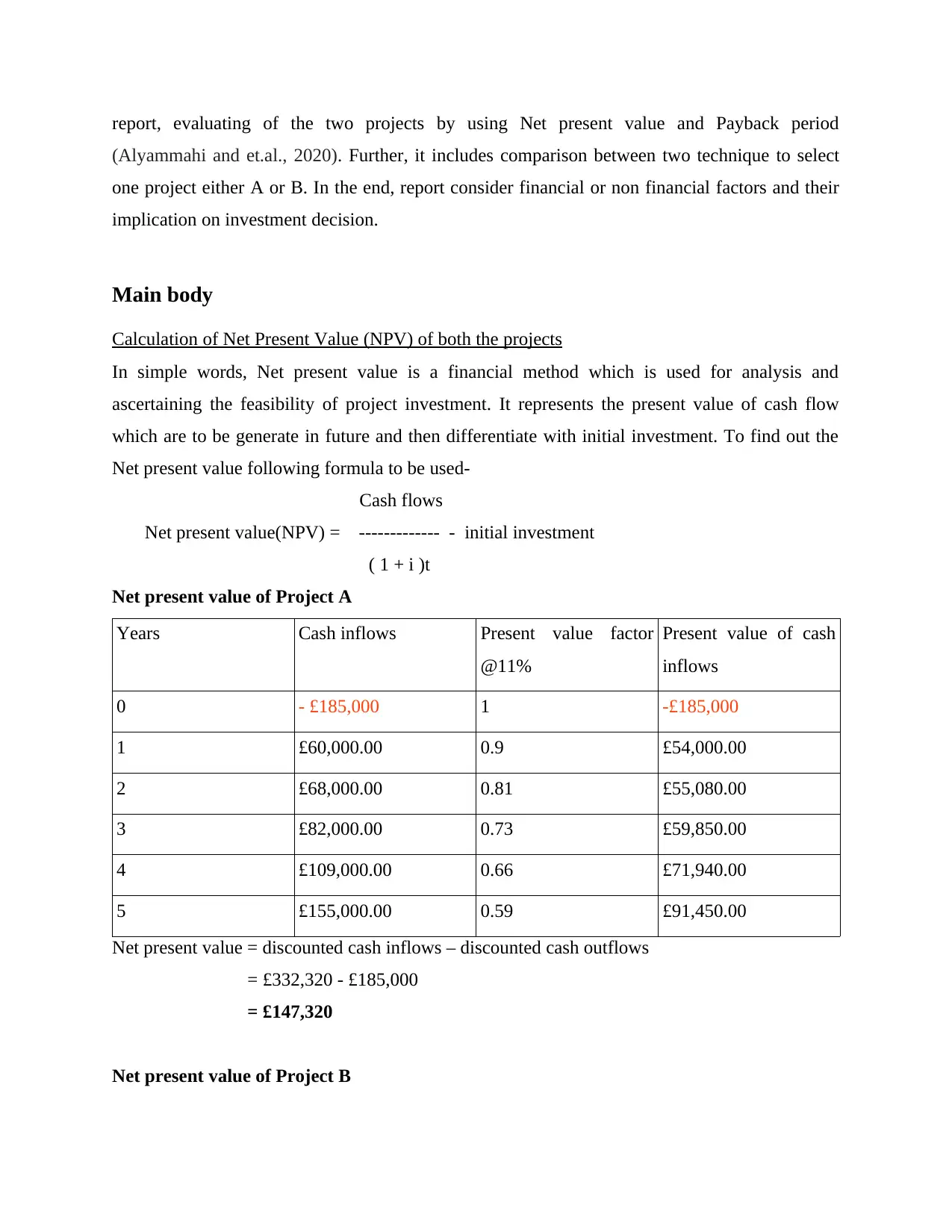
report, evaluating of the two projects by using Net present value and Payback period
(Alyammahi and et.al., 2020). Further, it includes comparison between two technique to select
one project either A or B. In the end, report consider financial or non financial factors and their
implication on investment decision.
Main body
Calculation of Net Present Value (NPV) of both the projects
In simple words, Net present value is a financial method which is used for analysis and
ascertaining the feasibility of project investment. It represents the present value of cash flow
which are to be generate in future and then differentiate with initial investment. To find out the
Net present value following formula to be used-
Cash flows
Net present value(NPV) = ------------- - initial investment
( 1 + i )t
Net present value of Project A
Years Cash inflows Present value factor
@11%
Present value of cash
inflows
0 - £185,000 1 -£185,000
1 £60,000.00 0.9 £54,000.00
2 £68,000.00 0.81 £55,080.00
3 £82,000.00 0.73 £59,850.00
4 £109,000.00 0.66 £71,940.00
5 £155,000.00 0.59 £91,450.00
Net present value = discounted cash inflows – discounted cash outflows
= £332,320 - £185,000
= £147,320
Net present value of Project B
(Alyammahi and et.al., 2020). Further, it includes comparison between two technique to select
one project either A or B. In the end, report consider financial or non financial factors and their
implication on investment decision.
Main body
Calculation of Net Present Value (NPV) of both the projects
In simple words, Net present value is a financial method which is used for analysis and
ascertaining the feasibility of project investment. It represents the present value of cash flow
which are to be generate in future and then differentiate with initial investment. To find out the
Net present value following formula to be used-
Cash flows
Net present value(NPV) = ------------- - initial investment
( 1 + i )t
Net present value of Project A
Years Cash inflows Present value factor
@11%
Present value of cash
inflows
0 - £185,000 1 -£185,000
1 £60,000.00 0.9 £54,000.00
2 £68,000.00 0.81 £55,080.00
3 £82,000.00 0.73 £59,850.00
4 £109,000.00 0.66 £71,940.00
5 £155,000.00 0.59 £91,450.00
Net present value = discounted cash inflows – discounted cash outflows
= £332,320 - £185,000
= £147,320
Net present value of Project B
⊘ This is a preview!⊘
Do you want full access?
Subscribe today to unlock all pages.

Trusted by 1+ million students worldwide
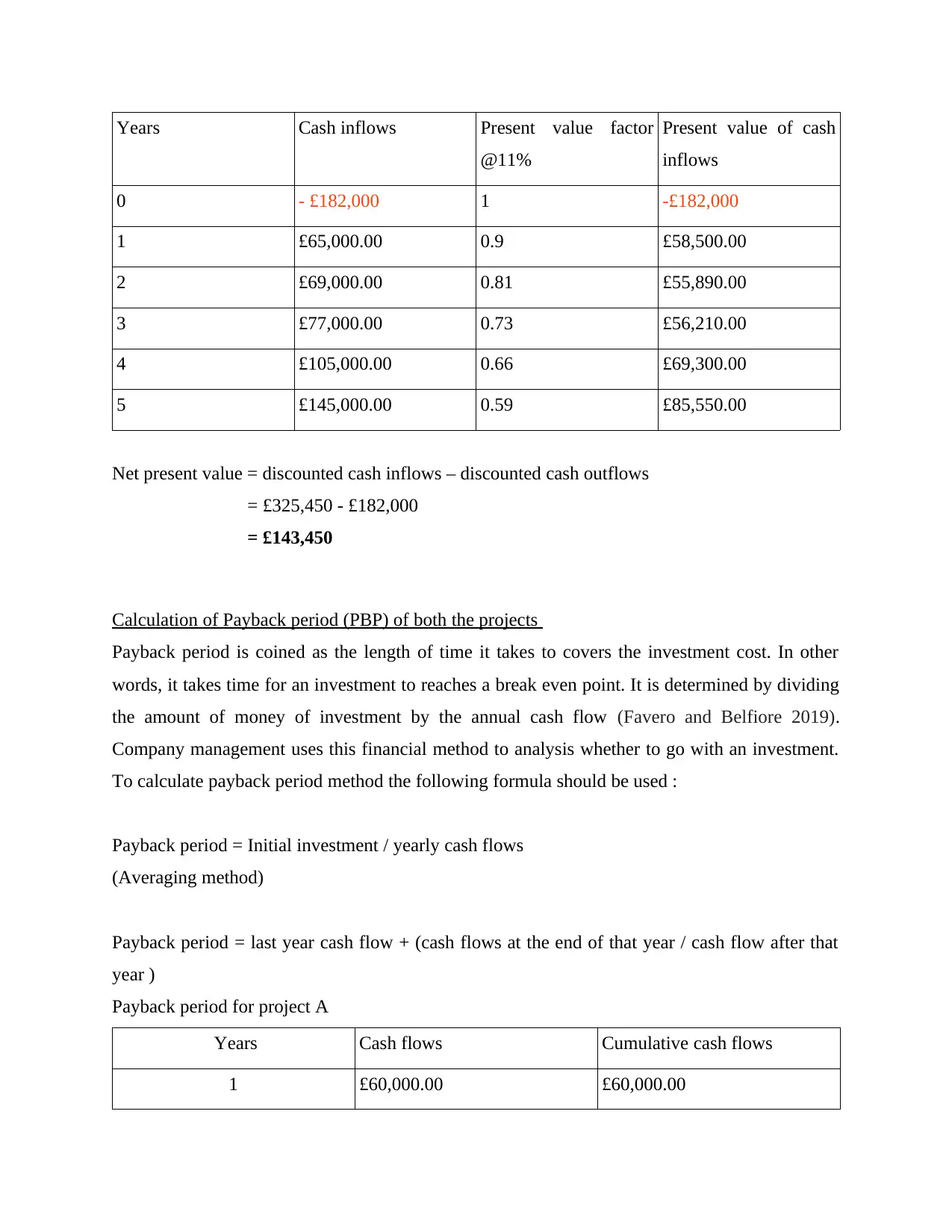
Years Cash inflows Present value factor
@11%
Present value of cash
inflows
0 - £182,000 1 -£182,000
1 £65,000.00 0.9 £58,500.00
2 £69,000.00 0.81 £55,890.00
3 £77,000.00 0.73 £56,210.00
4 £105,000.00 0.66 £69,300.00
5 £145,000.00 0.59 £85,550.00
Net present value = discounted cash inflows – discounted cash outflows
= £325,450 - £182,000
= £143,450
Calculation of Payback period (PBP) of both the projects
Payback period is coined as the length of time it takes to covers the investment cost. In other
words, it takes time for an investment to reaches a break even point. It is determined by dividing
the amount of money of investment by the annual cash flow (Favero and Belfiore 2019).
Company management uses this financial method to analysis whether to go with an investment.
To calculate payback period method the following formula should be used :
Payback period = Initial investment / yearly cash flows
(Averaging method)
Payback period = last year cash flow + (cash flows at the end of that year / cash flow after that
year )
Payback period for project A
Years Cash flows Cumulative cash flows
1 £60,000.00 £60,000.00
@11%
Present value of cash
inflows
0 - £182,000 1 -£182,000
1 £65,000.00 0.9 £58,500.00
2 £69,000.00 0.81 £55,890.00
3 £77,000.00 0.73 £56,210.00
4 £105,000.00 0.66 £69,300.00
5 £145,000.00 0.59 £85,550.00
Net present value = discounted cash inflows – discounted cash outflows
= £325,450 - £182,000
= £143,450
Calculation of Payback period (PBP) of both the projects
Payback period is coined as the length of time it takes to covers the investment cost. In other
words, it takes time for an investment to reaches a break even point. It is determined by dividing
the amount of money of investment by the annual cash flow (Favero and Belfiore 2019).
Company management uses this financial method to analysis whether to go with an investment.
To calculate payback period method the following formula should be used :
Payback period = Initial investment / yearly cash flows
(Averaging method)
Payback period = last year cash flow + (cash flows at the end of that year / cash flow after that
year )
Payback period for project A
Years Cash flows Cumulative cash flows
1 £60,000.00 £60,000.00
Paraphrase This Document
Need a fresh take? Get an instant paraphrase of this document with our AI Paraphraser
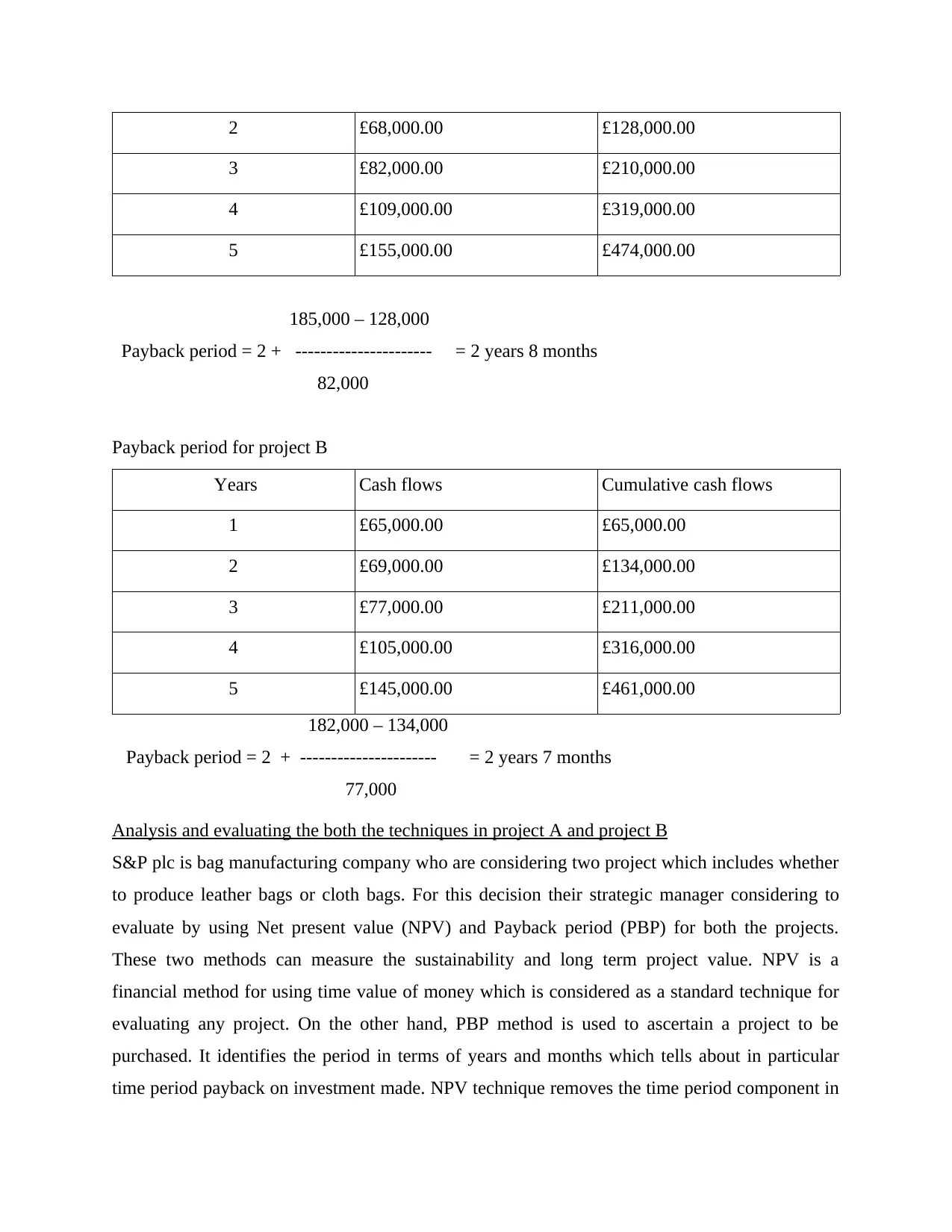
2 £68,000.00 £128,000.00
3 £82,000.00 £210,000.00
4 £109,000.00 £319,000.00
5 £155,000.00 £474,000.00
185,000 – 128,000
Payback period = 2 + ---------------------- = 2 years 8 months
82,000
Payback period for project B
Years Cash flows Cumulative cash flows
1 £65,000.00 £65,000.00
2 £69,000.00 £134,000.00
3 £77,000.00 £211,000.00
4 £105,000.00 £316,000.00
5 £145,000.00 £461,000.00
182,000 – 134,000
Payback period = 2 + ---------------------- = 2 years 7 months
77,000
Analysis and evaluating the both the techniques in project A and project B
S&P plc is bag manufacturing company who are considering two project which includes whether
to produce leather bags or cloth bags. For this decision their strategic manager considering to
evaluate by using Net present value (NPV) and Payback period (PBP) for both the projects.
These two methods can measure the sustainability and long term project value. NPV is a
financial method for using time value of money which is considered as a standard technique for
evaluating any project. On the other hand, PBP method is used to ascertain a project to be
purchased. It identifies the period in terms of years and months which tells about in particular
time period payback on investment made. NPV technique removes the time period component in
3 £82,000.00 £210,000.00
4 £109,000.00 £319,000.00
5 £155,000.00 £474,000.00
185,000 – 128,000
Payback period = 2 + ---------------------- = 2 years 8 months
82,000
Payback period for project B
Years Cash flows Cumulative cash flows
1 £65,000.00 £65,000.00
2 £69,000.00 £134,000.00
3 £77,000.00 £211,000.00
4 £105,000.00 £316,000.00
5 £145,000.00 £461,000.00
182,000 – 134,000
Payback period = 2 + ---------------------- = 2 years 7 months
77,000
Analysis and evaluating the both the techniques in project A and project B
S&P plc is bag manufacturing company who are considering two project which includes whether
to produce leather bags or cloth bags. For this decision their strategic manager considering to
evaluate by using Net present value (NPV) and Payback period (PBP) for both the projects.
These two methods can measure the sustainability and long term project value. NPV is a
financial method for using time value of money which is considered as a standard technique for
evaluating any project. On the other hand, PBP method is used to ascertain a project to be
purchased. It identifies the period in terms of years and months which tells about in particular
time period payback on investment made. NPV technique removes the time period component in
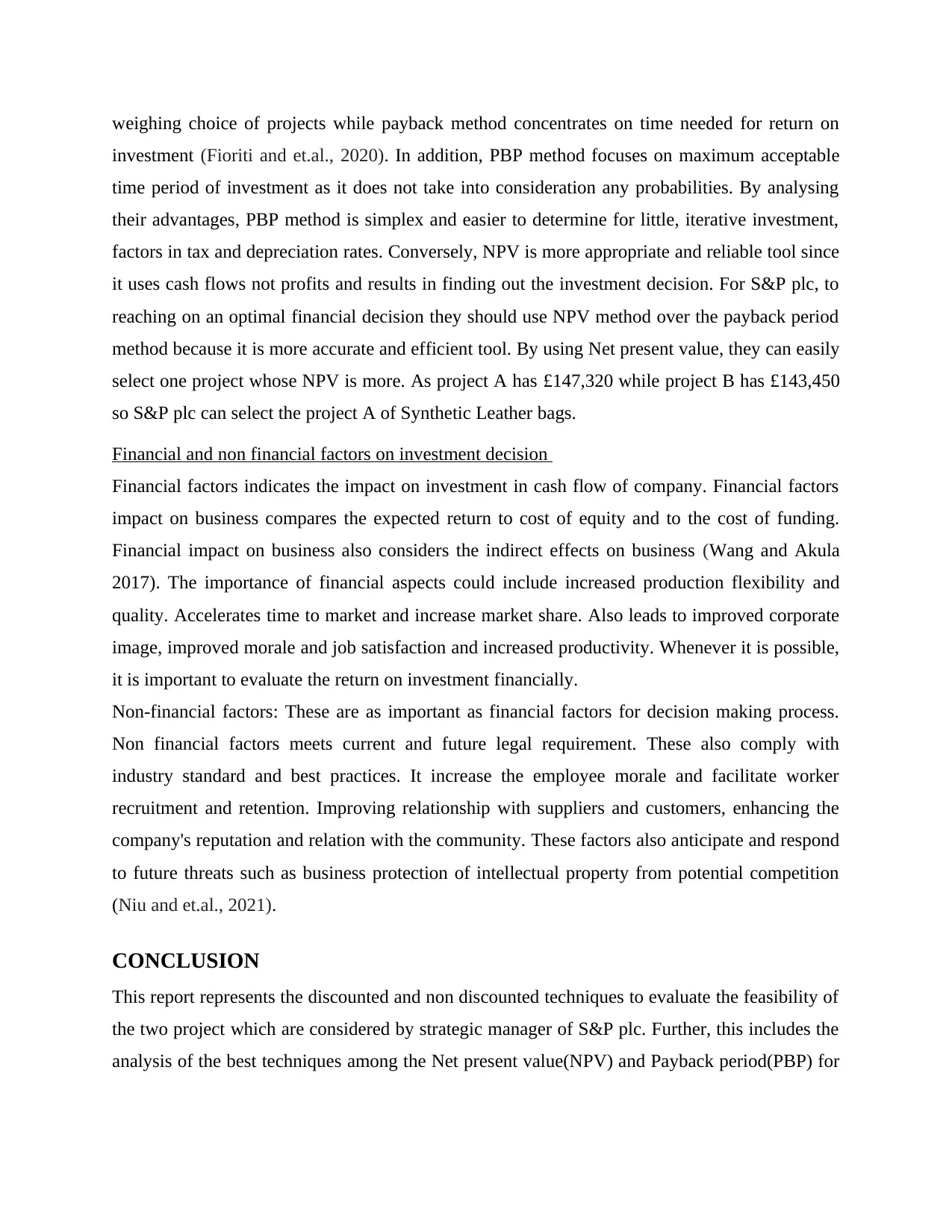
weighing choice of projects while payback method concentrates on time needed for return on
investment (Fioriti and et.al., 2020). In addition, PBP method focuses on maximum acceptable
time period of investment as it does not take into consideration any probabilities. By analysing
their advantages, PBP method is simplex and easier to determine for little, iterative investment,
factors in tax and depreciation rates. Conversely, NPV is more appropriate and reliable tool since
it uses cash flows not profits and results in finding out the investment decision. For S&P plc, to
reaching on an optimal financial decision they should use NPV method over the payback period
method because it is more accurate and efficient tool. By using Net present value, they can easily
select one project whose NPV is more. As project A has £147,320 while project B has £143,450
so S&P plc can select the project A of Synthetic Leather bags.
Financial and non financial factors on investment decision
Financial factors indicates the impact on investment in cash flow of company. Financial factors
impact on business compares the expected return to cost of equity and to the cost of funding.
Financial impact on business also considers the indirect effects on business (Wang and Akula
2017). The importance of financial aspects could include increased production flexibility and
quality. Accelerates time to market and increase market share. Also leads to improved corporate
image, improved morale and job satisfaction and increased productivity. Whenever it is possible,
it is important to evaluate the return on investment financially.
Non-financial factors: These are as important as financial factors for decision making process.
Non financial factors meets current and future legal requirement. These also comply with
industry standard and best practices. It increase the employee morale and facilitate worker
recruitment and retention. Improving relationship with suppliers and customers, enhancing the
company's reputation and relation with the community. These factors also anticipate and respond
to future threats such as business protection of intellectual property from potential competition
(Niu and et.al., 2021).
CONCLUSION
This report represents the discounted and non discounted techniques to evaluate the feasibility of
the two project which are considered by strategic manager of S&P plc. Further, this includes the
analysis of the best techniques among the Net present value(NPV) and Payback period(PBP) for
investment (Fioriti and et.al., 2020). In addition, PBP method focuses on maximum acceptable
time period of investment as it does not take into consideration any probabilities. By analysing
their advantages, PBP method is simplex and easier to determine for little, iterative investment,
factors in tax and depreciation rates. Conversely, NPV is more appropriate and reliable tool since
it uses cash flows not profits and results in finding out the investment decision. For S&P plc, to
reaching on an optimal financial decision they should use NPV method over the payback period
method because it is more accurate and efficient tool. By using Net present value, they can easily
select one project whose NPV is more. As project A has £147,320 while project B has £143,450
so S&P plc can select the project A of Synthetic Leather bags.
Financial and non financial factors on investment decision
Financial factors indicates the impact on investment in cash flow of company. Financial factors
impact on business compares the expected return to cost of equity and to the cost of funding.
Financial impact on business also considers the indirect effects on business (Wang and Akula
2017). The importance of financial aspects could include increased production flexibility and
quality. Accelerates time to market and increase market share. Also leads to improved corporate
image, improved morale and job satisfaction and increased productivity. Whenever it is possible,
it is important to evaluate the return on investment financially.
Non-financial factors: These are as important as financial factors for decision making process.
Non financial factors meets current and future legal requirement. These also comply with
industry standard and best practices. It increase the employee morale and facilitate worker
recruitment and retention. Improving relationship with suppliers and customers, enhancing the
company's reputation and relation with the community. These factors also anticipate and respond
to future threats such as business protection of intellectual property from potential competition
(Niu and et.al., 2021).
CONCLUSION
This report represents the discounted and non discounted techniques to evaluate the feasibility of
the two project which are considered by strategic manager of S&P plc. Further, this includes the
analysis of the best techniques among the Net present value(NPV) and Payback period(PBP) for
⊘ This is a preview!⊘
Do you want full access?
Subscribe today to unlock all pages.

Trusted by 1+ million students worldwide
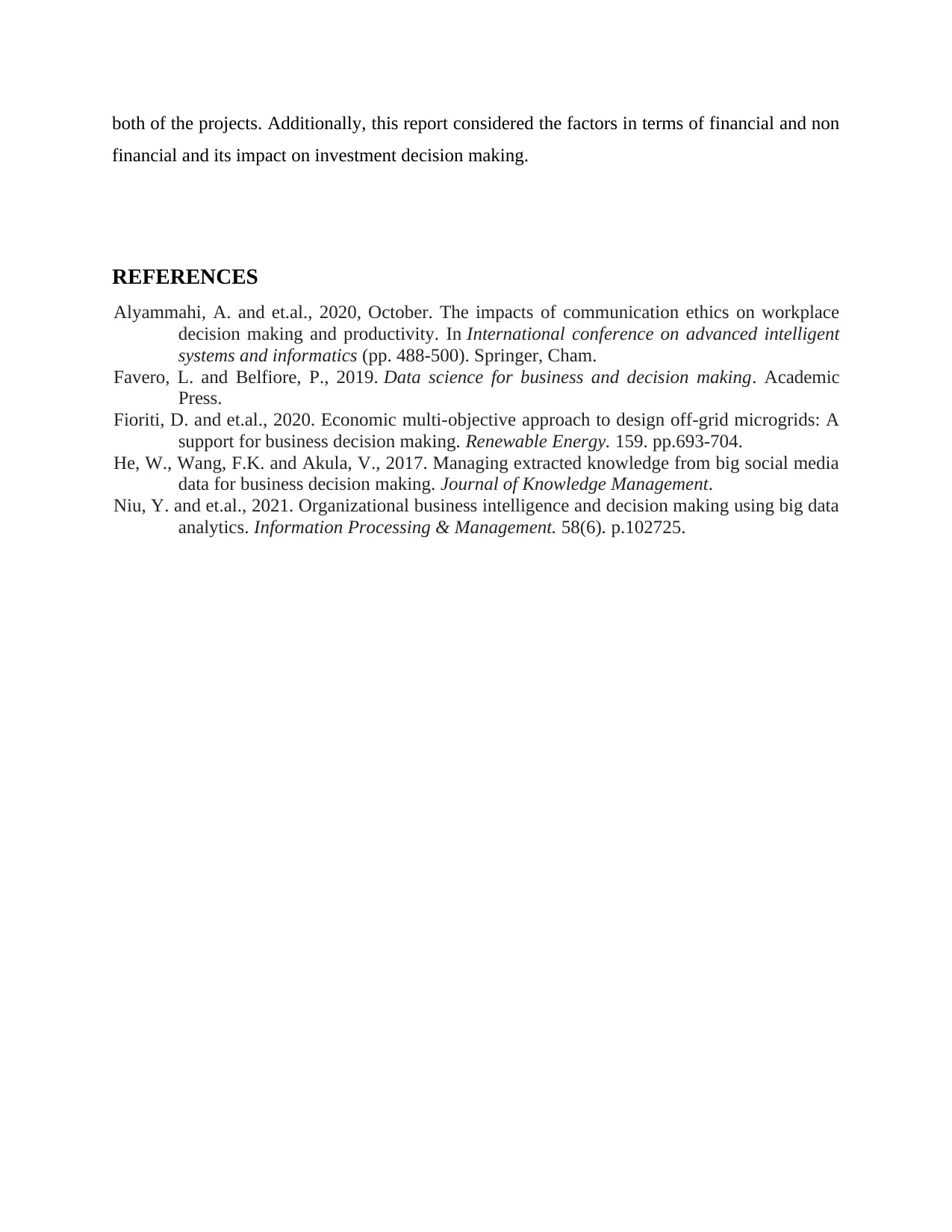
both of the projects. Additionally, this report considered the factors in terms of financial and non
financial and its impact on investment decision making.
REFERENCES
Alyammahi, A. and et.al., 2020, October. The impacts of communication ethics on workplace
decision making and productivity. In International conference on advanced intelligent
systems and informatics (pp. 488-500). Springer, Cham.
Favero, L. and Belfiore, P., 2019. Data science for business and decision making. Academic
Press.
Fioriti, D. and et.al., 2020. Economic multi-objective approach to design off-grid microgrids: A
support for business decision making. Renewable Energy. 159. pp.693-704.
He, W., Wang, F.K. and Akula, V., 2017. Managing extracted knowledge from big social media
data for business decision making. Journal of Knowledge Management.
Niu, Y. and et.al., 2021. Organizational business intelligence and decision making using big data
analytics. Information Processing & Management. 58(6). p.102725.
financial and its impact on investment decision making.
REFERENCES
Alyammahi, A. and et.al., 2020, October. The impacts of communication ethics on workplace
decision making and productivity. In International conference on advanced intelligent
systems and informatics (pp. 488-500). Springer, Cham.
Favero, L. and Belfiore, P., 2019. Data science for business and decision making. Academic
Press.
Fioriti, D. and et.al., 2020. Economic multi-objective approach to design off-grid microgrids: A
support for business decision making. Renewable Energy. 159. pp.693-704.
He, W., Wang, F.K. and Akula, V., 2017. Managing extracted knowledge from big social media
data for business decision making. Journal of Knowledge Management.
Niu, Y. and et.al., 2021. Organizational business intelligence and decision making using big data
analytics. Information Processing & Management. 58(6). p.102725.
1 out of 7
Related Documents
Your All-in-One AI-Powered Toolkit for Academic Success.
+13062052269
info@desklib.com
Available 24*7 on WhatsApp / Email
![[object Object]](/_next/static/media/star-bottom.7253800d.svg)
Unlock your academic potential
Copyright © 2020–2025 A2Z Services. All Rights Reserved. Developed and managed by ZUCOL.



